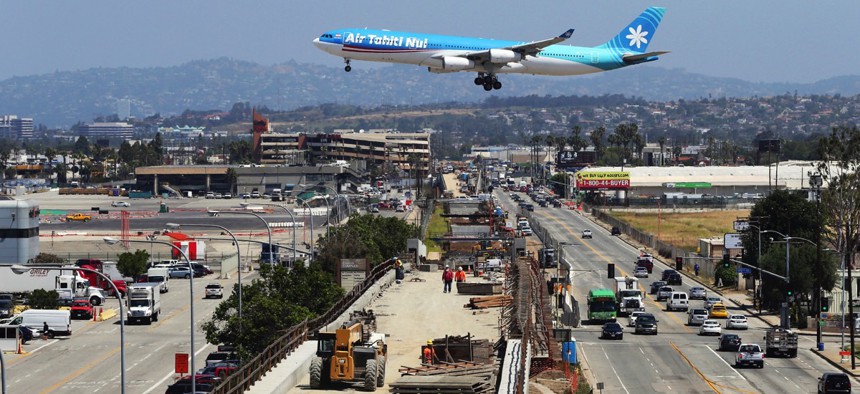L.A. Is Ready to Build Even More Transit. But There’s Always a But.

An airliner prepares to land at Los Angeles International Airport over the Metro Crenshaw/LAX Line, en extension of the city's transportation network as the city seeks the 2024 Summer Olympic Games. Reed Saxon / AP Photo
Projects like completing the long-awaited Westside subway could be way ahead of schedule—assuming federal support will be there.
The Los Angeles County Metropolitan Transportation Authority could be working on additional phases of its long-awaited Westside subway extension up to nine years ahead of schedule , made possible with the passage of a half-percent sales tax increase in November.
Measure M, as approved by voters, projects an estimated $860 million in additional annual revenue for 40 major transit and highway projects across the county in 40 years. About 2.3 million people are projected to move to the county during that time, increasing demands on the regional transportation network that current serves a population of 10 million residents.
L.A. Metro’s Purple Line subway under Wilshire Boulevard is currently being extended westward nearly 4 miles thanks to funding from the 2008 Measure R county tax measure. The next phases of expansion take the Purple Line through Beverly Hills, Century City and Westwood.
In late April, the agency issued a “notice to proceed” for Phase 2 of the project, which would bring subway service to Century City.

As L.A. Metro’s The Source reported on April 27:
With the passage of Measure M, the agency has said it is aiming to finish the entire subway to Westwood by 2024 and in time for a potential 2024 Summer Olympics.
But the naming of L.A. as a future Olympics host city is not assured, as is the assumption that federal funding will continue to flow to the nation’s most populous county in the same way it was during the Obama administration.
In its recently released federal budget proposal, the Trump administration mentioned L.A. Metro in its language justifying major cuts to transit funding programs, saying that agencies should "realize waiting for grant funding is not the most efficient way to meet their local transportation needs."
L.A. Metro rebuffed the notion local tax referendums like Measure M were a replacement for federal funds in a joint statement it released last week with Sound Transit , a regional agency which is building a light-rail network in the Seattle area:
"The administration's assertion that our regions can deliver transit solutions for our citizens without federal partnership is uninformed, misguided, and unfair. The voters of our communities stepped up and voted to tax themselves to provide a path out of punishing congestion. For that bold action, they should be rewarded at the federal level, not punished.
For Sound Transit, $1.1 billion in federal funding for Lynnwood Link—a previously approved light-rail extension from Seattle northward into Snohomish County—is now in jeopardy in the current White House budget proposal, The Seattle Times reported last week .
Like in Los Angeles County, voters in the central Puget Sound region approved a major transit expansion measure on the November ballot , which would expand the Sound Transit light-rail network to 115 miles.
L.A. Metro currently has a fleet of about 2,000 buses on 170 routes and 105 miles of subway and light-rail lines.
Measure M will help fund projects across L.A. County like: Better transit connections for LAX Airport, including a new Airport Metro Connector station ; an additional extension of the Gold Line to Montclair and another from East L.A. to either Whittier or South El Monte ; bus rapid transit improvements for the Orange Line in the San Fernando Valley , with the aim of upgrading the corridor for light-rail service; extending the Crenshaw / LAX light-rail line that’s currently under construction northward to the Red Line in Hollywood; and transit enhancements through Sepulveda Pass along the 405 Freeway connecting the Westside and San Fernando Valley.
Street improvements and repairs in the 88 cities in the county are also part of the Measure M plan, as are new bike and pedestrian connections to solve first-mile and last-mile problems with what Metro hopes will become an end-to-end multimodal transportation system.
Dave Nyczepir is a News Editor at Government Executive’s Route Fifty and is based in Washington, D.C.
NEXT STORY: Next up: Integration of virtual machines, containers






